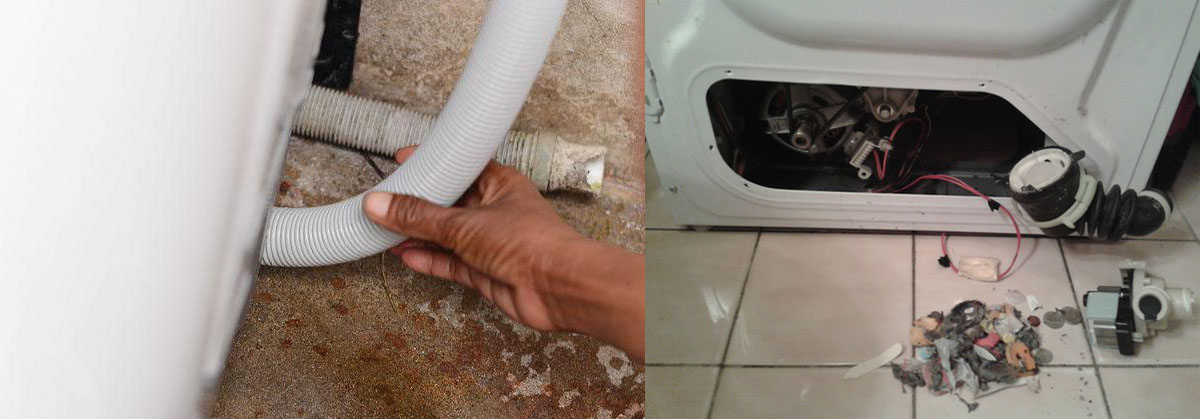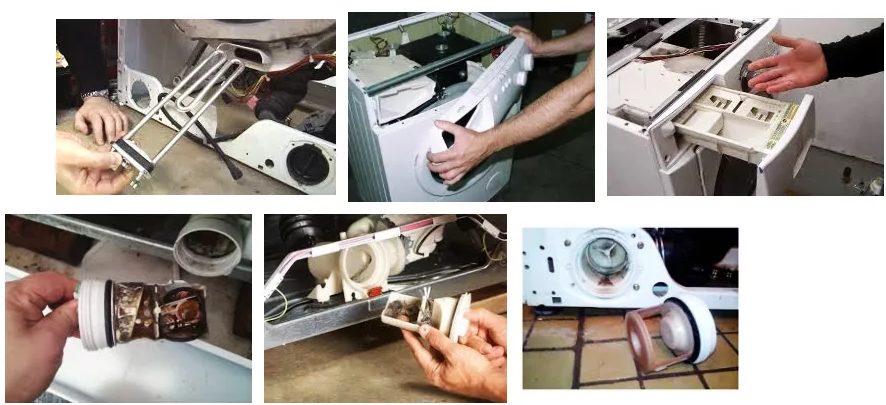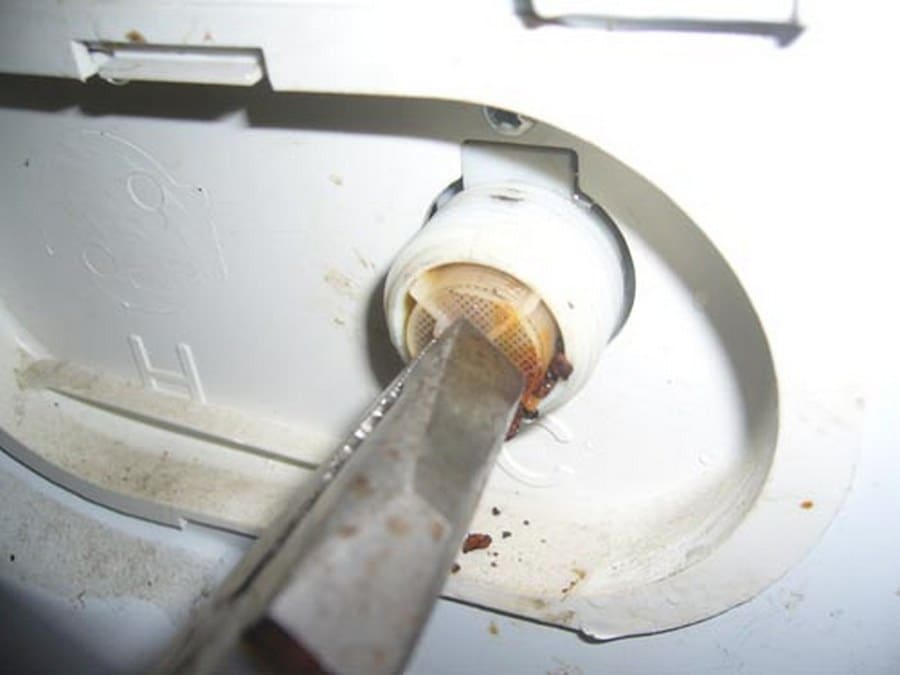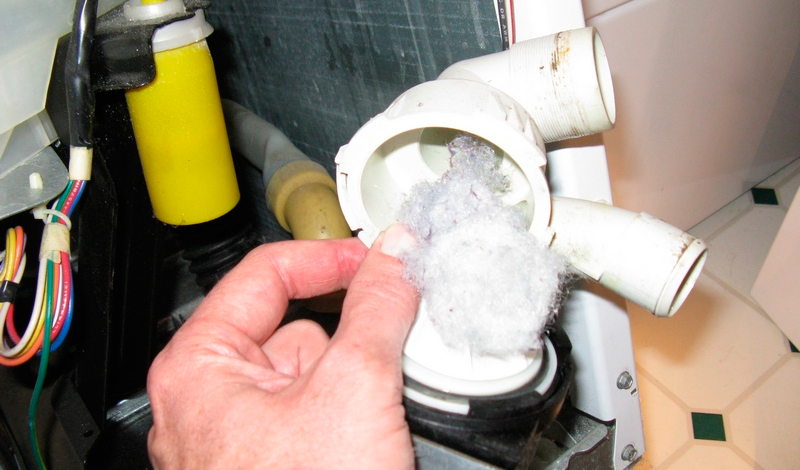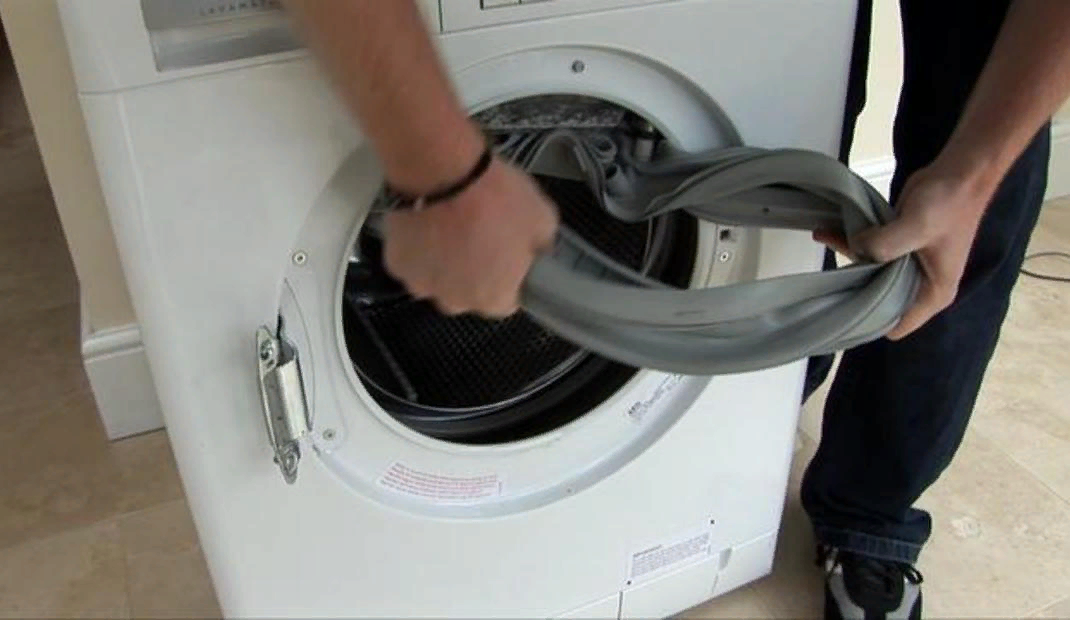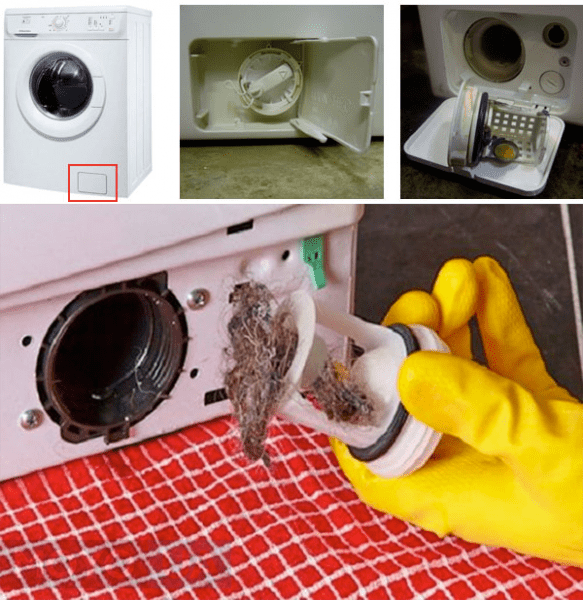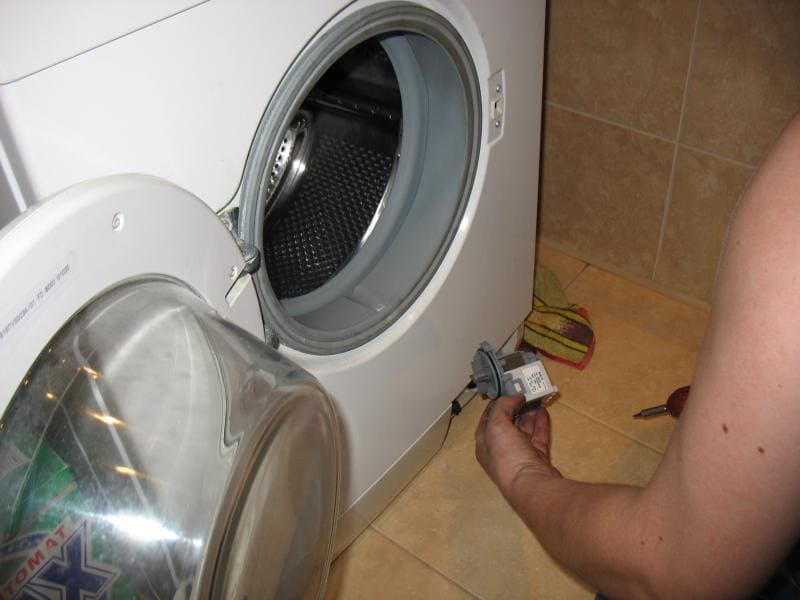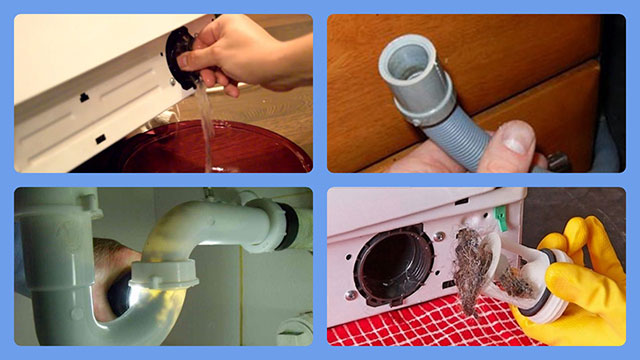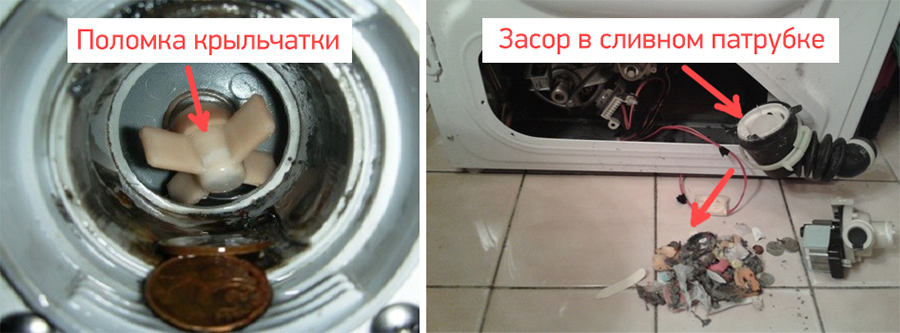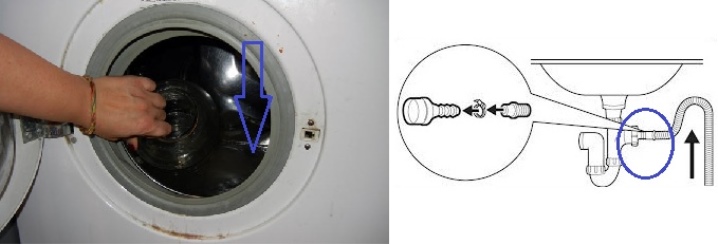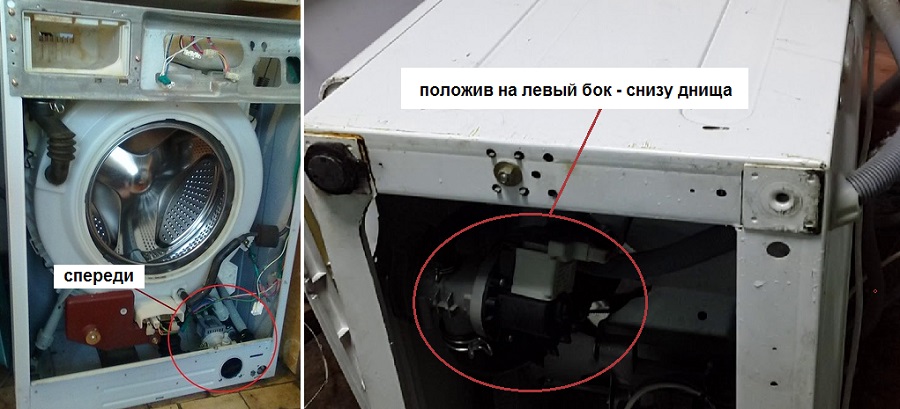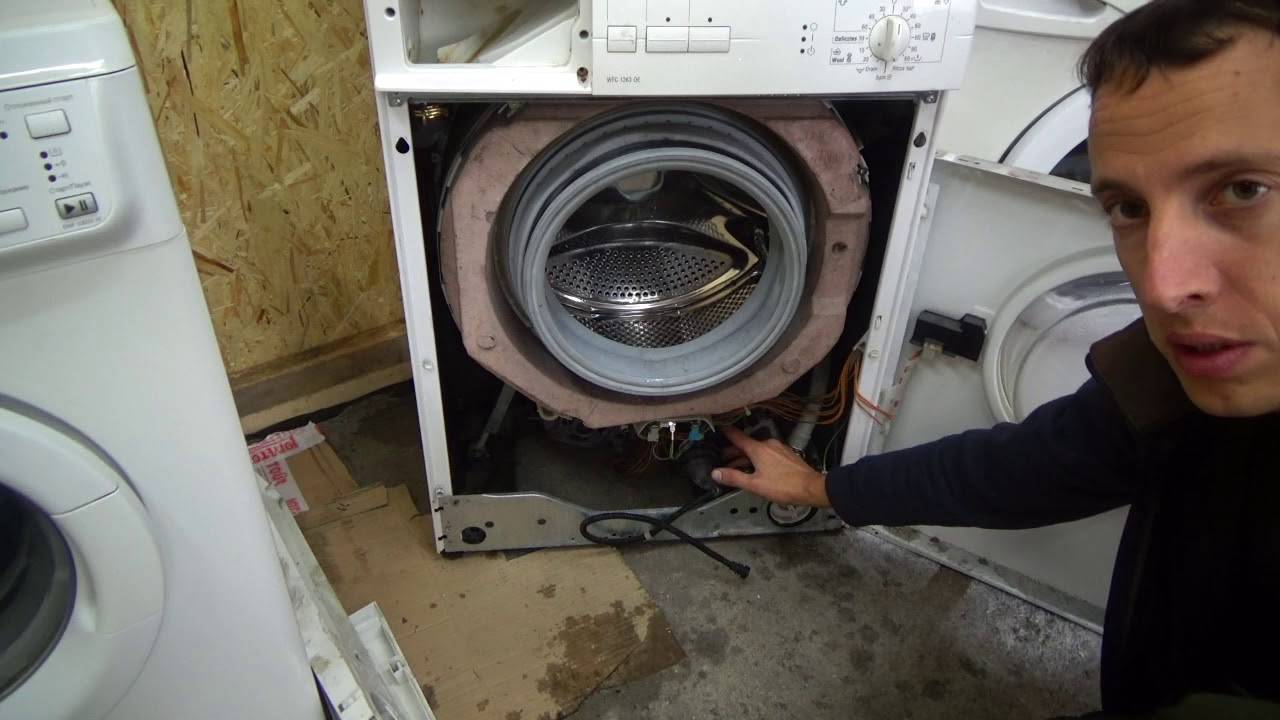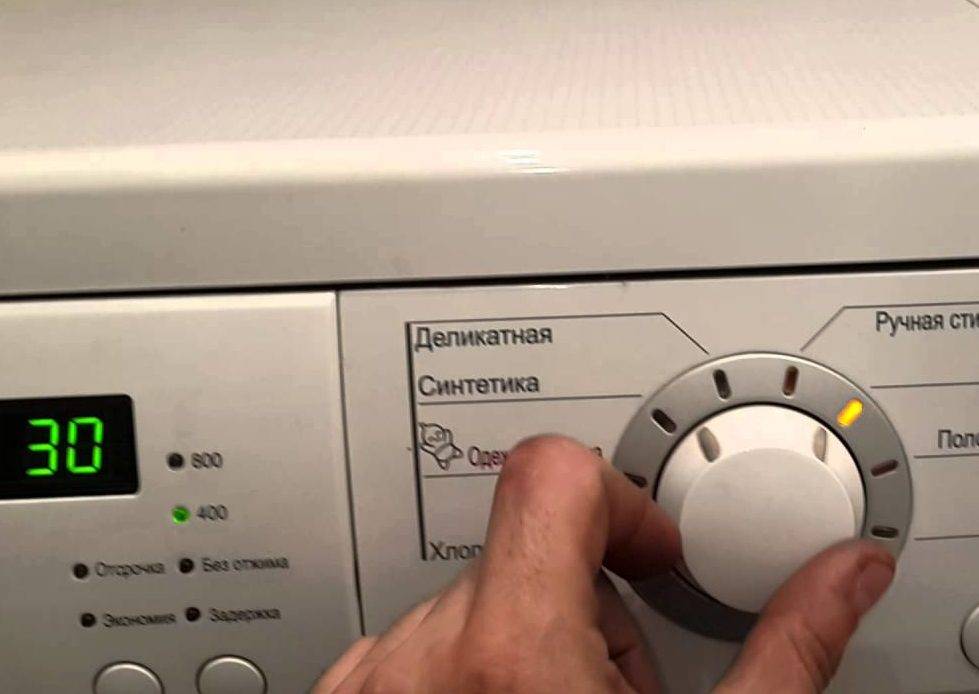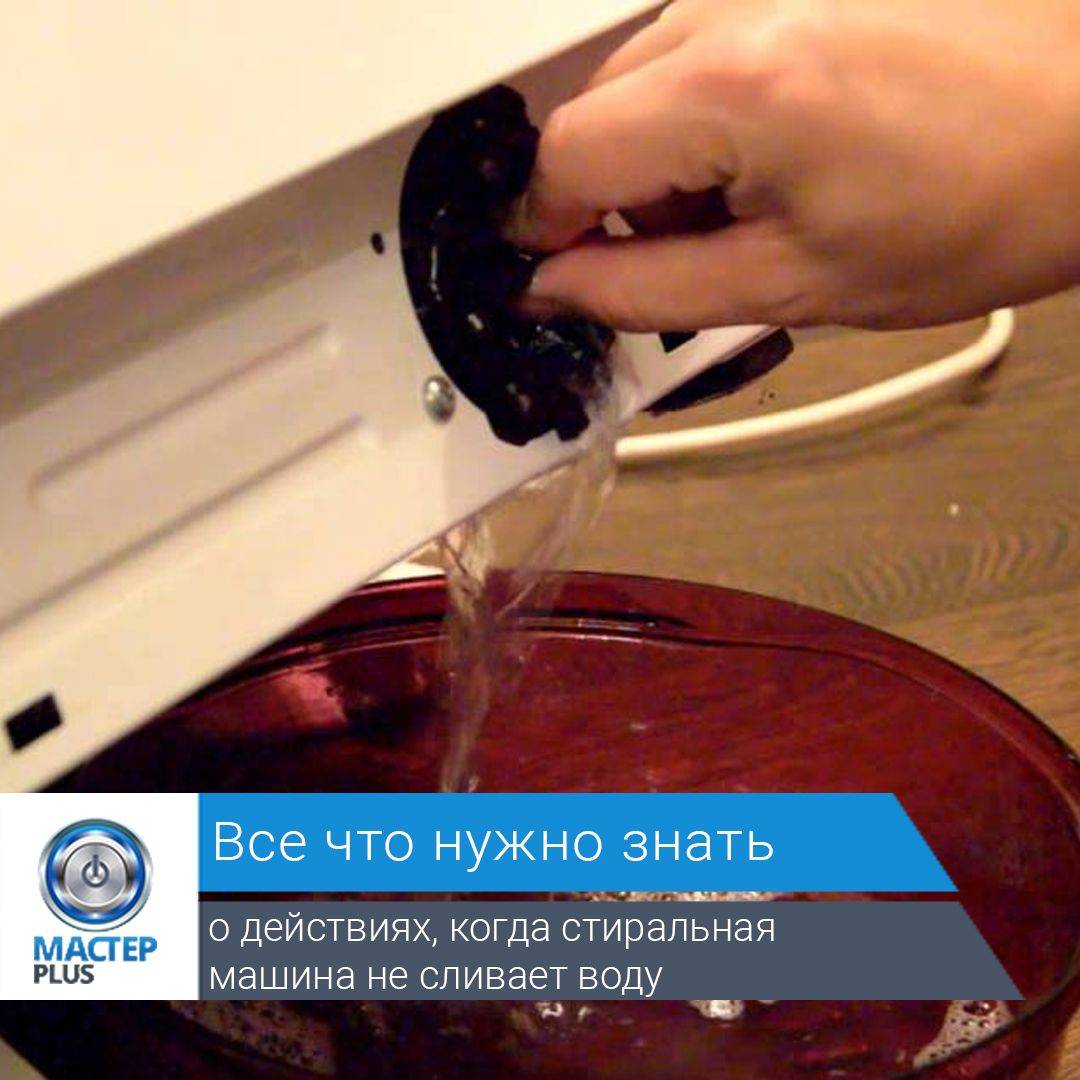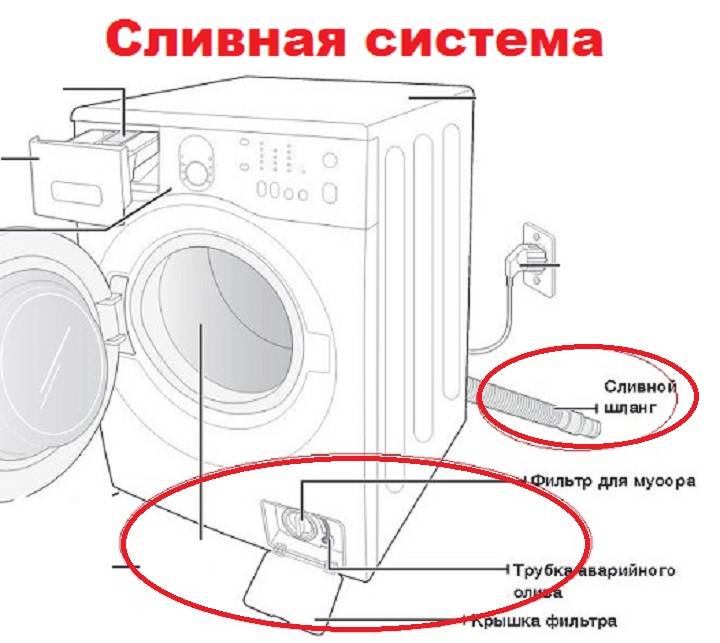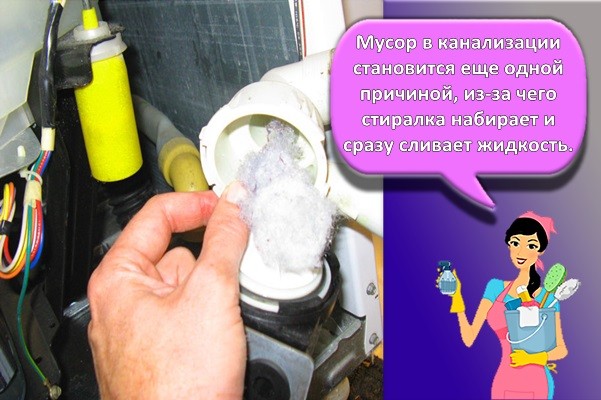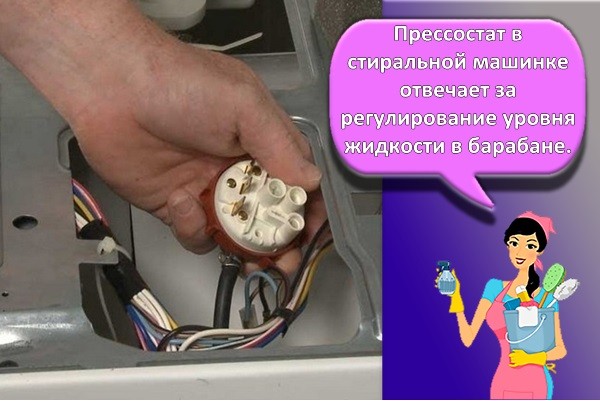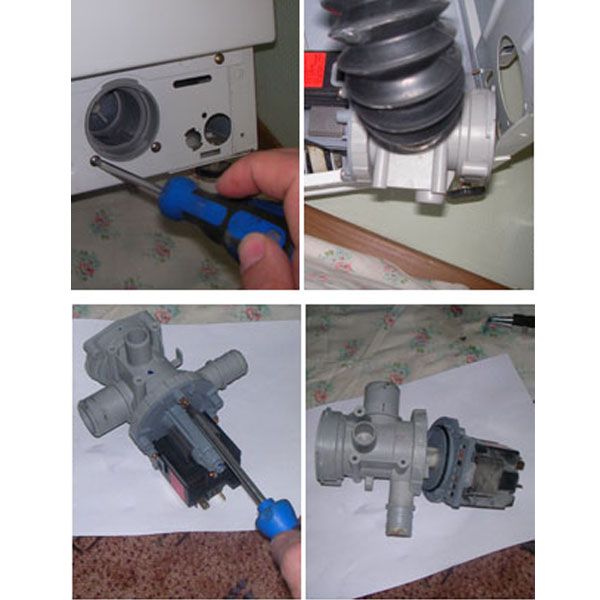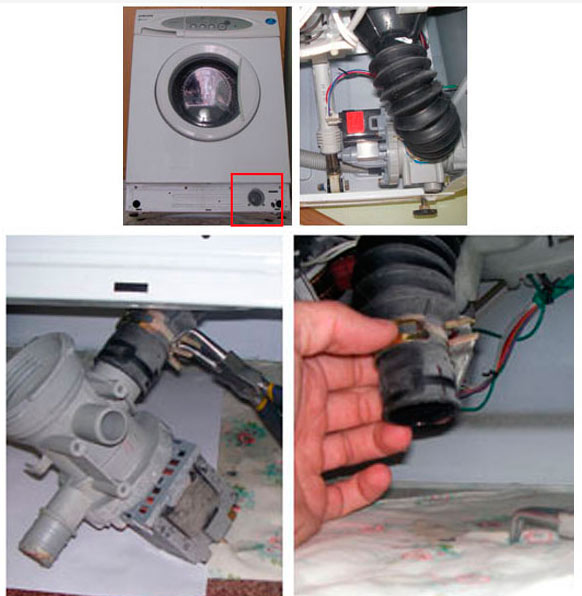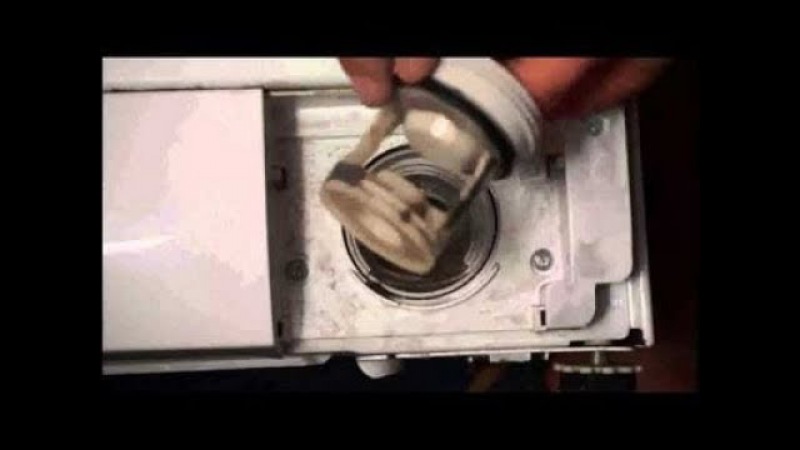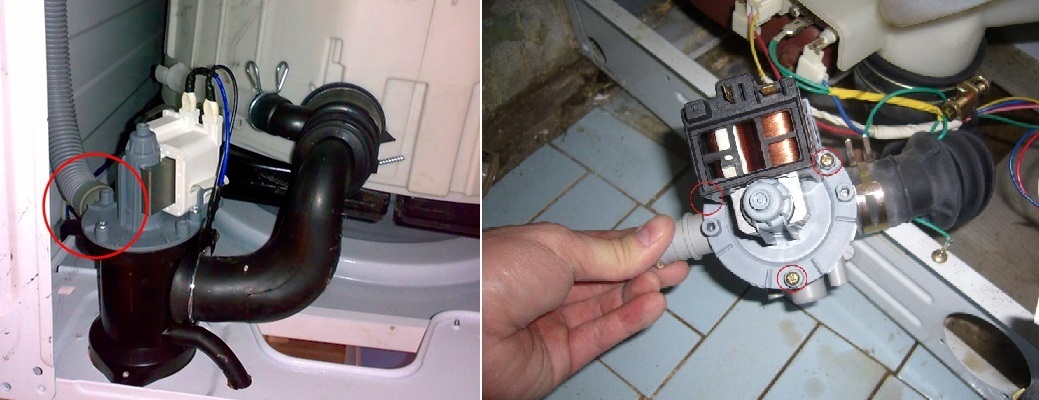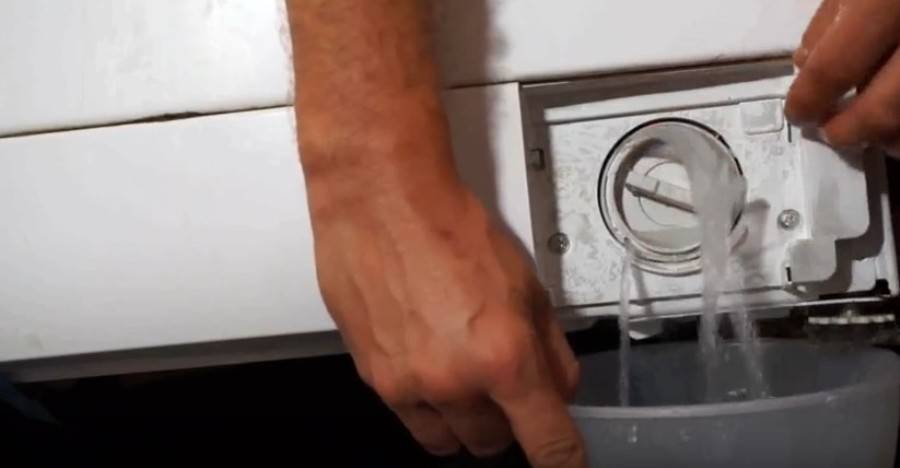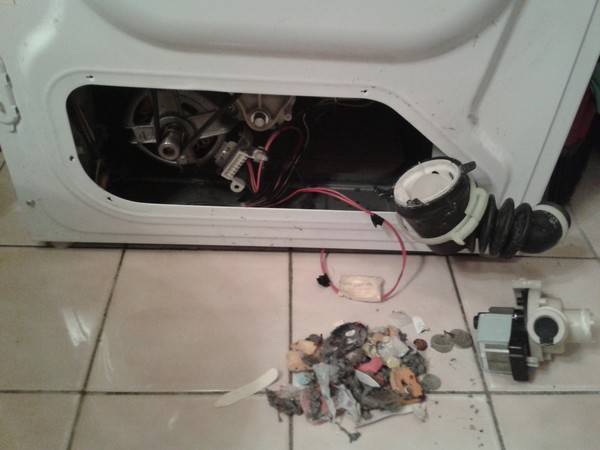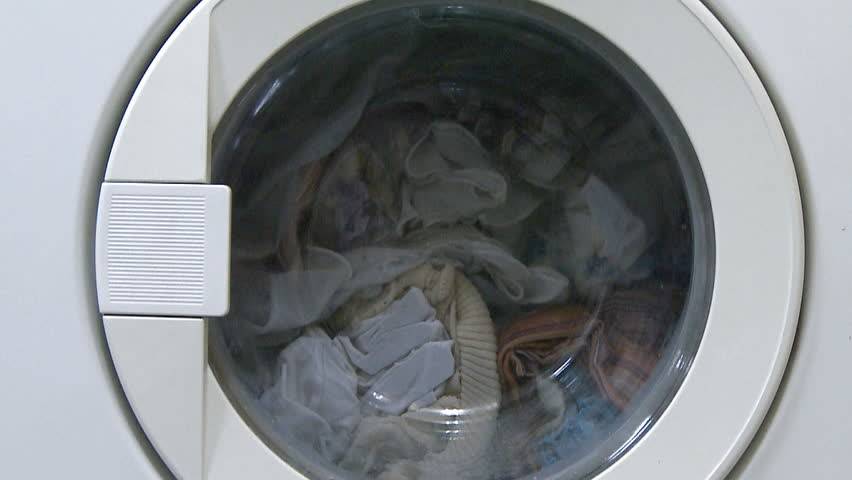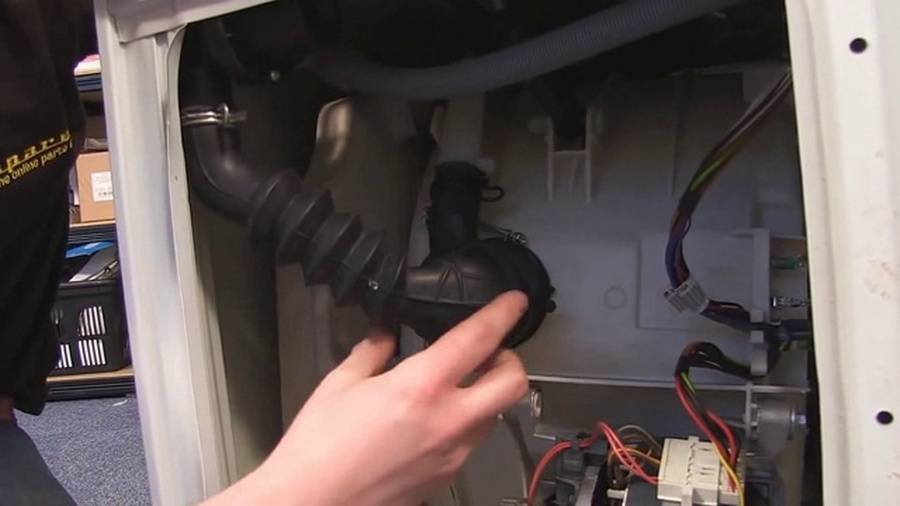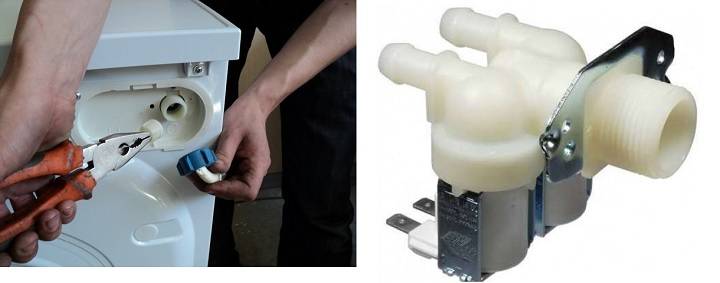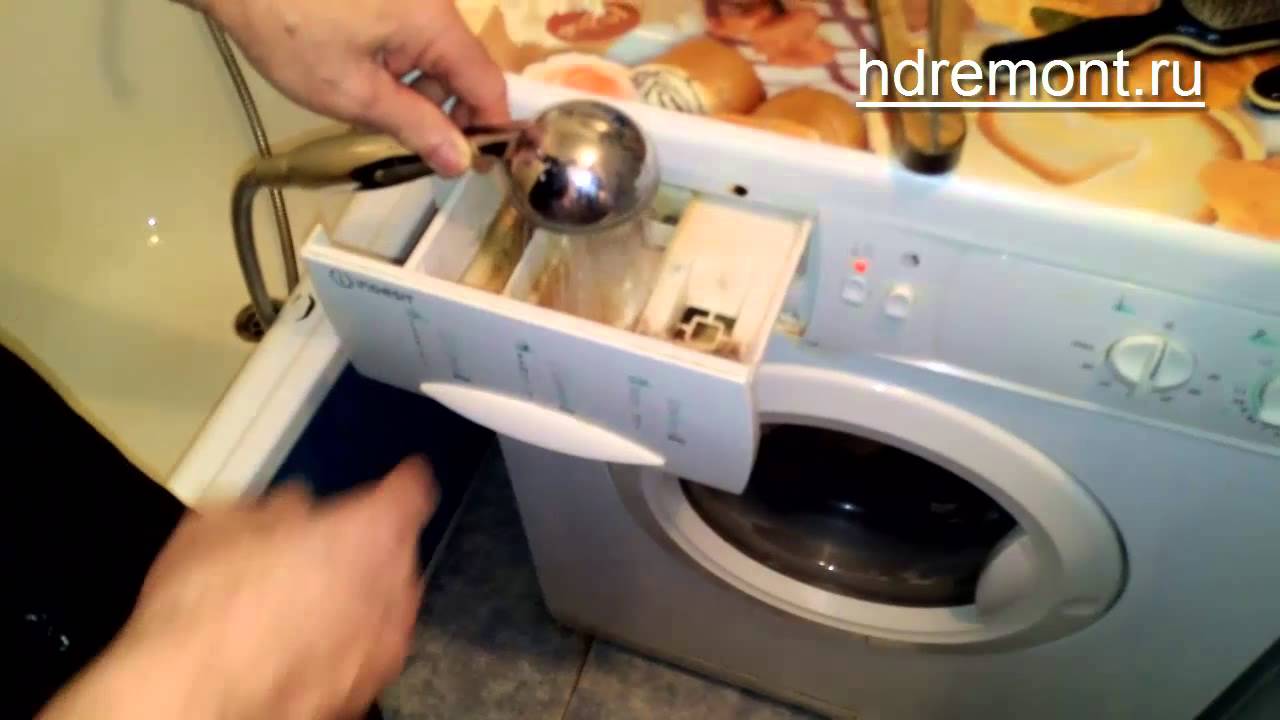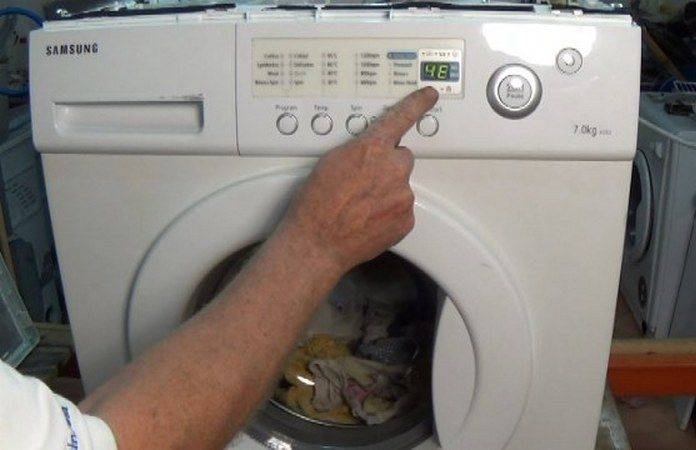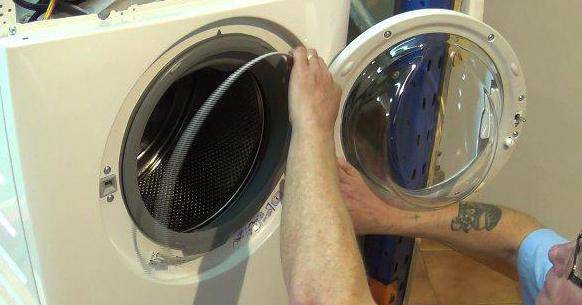It is worth noting that the breakdown of the intake valve and some other reasons also contribute to the constant collection of water. While the machine washes, it repeatedly draws and drains water in one cycle, but this should not happen all the time throughout the wash. Here the reason lies either in its incorrect installation, or in the presence of a malfunction. It is highly discouraged to operate such a machine - this can lead to more serious damage and flooding of neighbors.
First of all, you should check the connection with the sewer pipe. If the drain hose is located below the tank, the module recognizes this as a lack of water during filling, and therefore refills. The next fill is done in the same way. This wash cycle is called "siphon wash".
Checking the correctness of the connection
It should be understood that the correct position of the drain hose is above the tank. From the floor to the connection to the siphon or sewer pipe, the distance should vary from 50 to 60 centimeters. This must be taken into account when connecting.
However, not in all cases it is possible to check this due to unavailability. Any locker or "screen" on the bathroom can interfere.
In this case, the following sequence of actions should be performed:
- Start the program (you can wash it quickly).
- Wait until the tank is filled with water.
- Switch on drain mode.
- As soon as the water begins to decrease, press pause, and if at this moment the water remains at the same level, then the machine is connected correctly.
- If there is a characteristic sound indicating draining, or visualization of a decrease in the water level, it is recommended to postpone the wash and seek help from a specialist.

Why does the washing machine take in water and drain it right away?
If a malfunction of the water supply was detected immediately after installation, then the connection of the machine to the sewer is incorrect. Other reasons include:
- Breakdown of the electronic control module.
- Malfunction of the electronic control unit.
- Washer tank leaking.
- The inlet valve is defective.
- Problem with water level sensor, pressure switch.
- Blockage in the drain or sewer system.
Inlet (filler, inlet) valve malfunction
The inlet valve supplies water to the tank. A failed part does not block the water, the tank is filled completely, the machine immediately drains without washing. If the valve has a weak diaphragm, water will seep out even when closed. A leak can be seen under the car.
He hopes that the problem will disappear by itself hopelessly. You need to immediately call the master at home. Often an experienced technician will change the valve.
Faulty pressure switch - water level sensor
The pressure switch is the most important element of the washing machine, the machine determines the amount of water in the tank, gives a command to the filling valve to supply water. The filling of the tank is determined by the pressure of the water column. The filling tube of the sensor becomes clogged due to small debris, scale and stops working correctly, giving deliberately false information about how much liquid is in the drum. The blockage is more likely to occur in the hoses and transducer plugs. If the water level sensor breaks down, the part gives out incorrect data and therefore constantly pours water. It is not so easy to independently check the performance of a part. Professional help is required in diagnostics, repair or replacement of a spare part.
Our service center has formed its own warehouse of the necessary spare parts. Therefore, we are always ready to make urgent repairs to your home assistant.We use only proven original spare parts from official manufacturers. That is why we give a guarantee for the work of the master and accessories.
Washing machine tank leak
Notice that the washing machine is leaking water? Let's deal with the problem. First of all, a crack in the tank is possible. This happens if, before washing, users forget to empty their pockets and metal parts: coins, tokens, could get into a small space between the drum and the tank of the machine. Service technicians recommend immediate replacement of the tank. Although many people limit themselves to using moisture-resistant glue, the machine will let water through again.
Another reason for the leak: The gasket between the two halves of the washing machine tank is dry and leaking. It is required to replace the element, it is better to call the master, since the machine will have to be completely disassembled. If the machine has a whole tank, this cannot happen.
Incorrect connection of the washing machine
If connected correctly, the drain hose is located above the tank: it is attached to a siphon or directly to a sewer pipe, at a height of 60 cm from the floor. Have you recently connected a typewriter, and it constantly draws water? We check at what height the drain is located.
It so happens that it is not possible to consider the connection point because of the wall, the screen. Then a simple test can be done. When draining the water during rinsing, press pause. If the water continues to decrease, then the point is in the installation of the machine. Don't put off calling a technician until later. The machine may fail.
Breakdown of the control unit (electronic module)
The reason why the washing machine does not hold water is a malfunction of the electronic control unit, which is responsible for the operation of many components of the machine, including the pressure switch, pump, heating element and other elements. If the firmware has "flown", then the simultaneous launch of the functions of filling and draining is possible. An electronic scoreboard helps to recognize a breakdown, where an error code is displayed. Malfunction of the electronic module is one of the most frequent breakdowns of Candy, LG, Ardo washing machines. This is the most essential part of the machine, it is worthwhile to approach the repair responsibly and call a professional technician. After all, the cost of a new control unit is quite high, and a specialist can restore the original control unit.
First aid in the absence of water supply
- Check that the tap through which the water is supplied is open.
- If it was open, then you need to block it. Then disconnect the water supply hose (located at the back of the machine) and lower it into a plastic container. Water will pour out of it.
- See if the hose is kinked and straighten kinks along its entire length.
- We unscrew the hose from the washing machine.
- A valve system appears in front of us, into which a mesh filter is inserted. The filter has a special indent, so we take the pliers and, grasping this indent, pull out (do not twist) the mesh filter.
- The mesh can be cleaned with a needle under the pressure of water and inserted into the valve using pliers.

Why is it better to contact a master?
The main disadvantage of constantly draining and collecting water is the complete flushing of powder and other products. In this case, the machine will not remove dirt. In addition, with such an operation, the tubular electric heater experiences an extreme load, since it constantly tries to heat the water that has just been poured into the tank. The result is a corresponding error on the screen, a breakdown of the heating element and expensive repairs.
Of course, the correct connection diagram is contained in the instructions for the machine. Everyone can figure it out, but the correct connection will need to be checked without fail.
Independent work will not give a positive result in all cases. Lack of experience often leads to even more serious malfunctions. The craftsmen have both experience and special equipment.In a short time period, they connect the machine, bringing the hose to the correct position or installing an anti-siphon valve. It is installed in exceptional cases, since it requires periodic cleaning.
Possible violations of operating rules
Sometimes the reason for washing without spinning can be caused by banal carelessness.
Wash program selected incorrectly
In this situation, the spinning does not work in the appliance. But rushing to twist wet things with your hands is not an option. It is better to read the instructions carefully. Not every wash program has a spin function. Sometimes the laundry spins out at a low drum speed, or the wash cycle ends with a rinse. Then the water is drained from the car, but the things inside remain wet. If, after opening the hatch door, the presence of water in the tank is detected, you need to check how the program options are set. Perhaps spinning is not expected initially. For example, if a gentle mode is selected for things made from delicate types of fabrics, and so on. The problem is not that, since everything will be fixed by resetting the regulator to the desired function.
But it also happens that the spin is simply accidentally turned off by one of the household members. To squeeze out the washed items in this case, you just need to reset the regulator to the "Spin" option, and start the process using the "Start" button. The number of revolutions on the regulator is not set - also one of the banal reasons for a non-accidental spin. At the zero mark, the machine does not provide for spinning the laundry. The water will simply drain and the cycle will end.
Uneven distribution of laundry
This is what upsets the balance of the washing machine. Models with a display will report a balancing problem with the information code UE or E4. In other devices, the washing process simply stops at the spin stage, and all indicators light up at the same time. Often, if an imbalance occurs, the laundry in the drum becomes lumpy. And also the incorrect loading of bedding leads to a crash in the program. For example, when they were stacked in a tank. To eliminate the imbalance, it is enough to manually distribute the laundry evenly.
Drum overload
Eliminating weight overload is the easiest thing to do. You just have to remove some of the laundry from the washing machine. Or try to redistribute things, and restart the "Spin" function. Exceeding the maximum permissible weight poses a danger to the device, therefore, in case of such a violation, an error code is displayed on the display or the whole process is stopped. The situation can be easily solved by turning off the power and removing some of the items from the washing tub. To prevent overloading the drum in the future, load the laundry according to the instructions for use.
It is important to take into account the fact that wet clothes become heavier, therefore maximum load is undesirable.
Imbalance and overloading are equally unsafe for washing machines. Automation stops work before the start of the most active phase of washing - spinning at high speeds.
Why doesn't the tank hold water
There are several reasons why the washing machine will immediately drain the water after dialing. The simplest and most easily removable:
The device is incorrectly connected to the sewer. If the drain hose is below a certain height (for LG and Hansa it is 50 cm, for Candy and Indesit 60 cm), the flow of water, according to the laws of physics, will constantly flow into the drain automatically. To avoid this, check if the drain is properly connected to the system. If you find errors, invite a specialist.
There is a blockage in the drain. Because of this, the pressure in the drain pipes increases, and the contents of the drum simply begin to be drawn into them. This breakdown is especially common in old houses, where the sewer passages are outdated, covered with plaque and easily clogged. You can eliminate the problem by cleaning the pipes.
Please note that it is impossible to continue washing with blockages, despite the fact that the machine quickly draws water back, in this situation the heating element is loaded too much and may burn out.
The rest of the reasons lie in the breakdown of the internal parts of the washing machine. You need to understand them in more detail in order to understand how to proceed.
Set valve stuck
One of the most vulnerable parts is located next to the inlet hose and is responsible for opening or shutting off the flow from the water supply to the drum in time. If the intake valve breaks down, it continuously pours water into the system, and the device immediately drains it. To find out if there is really a problem in it, stop the wash and set the drain mode, then press pause and listen. If water continues to flow, then the valve has stopped working normally.
If the service offered you to fix this part, it is better not to agree to it. Technologists at the Ardo and Whirlpool factories argue that any damage to the intake valve is irreversible. It is recommended to install the original spare part.
Water level sensor is malfunctioning
The pressure switch is located closest to the washing tank. It checks how full the tank is and transmits this information to the control unit. If the high pressure pipe gives a signal that there is not enough liquid, the device begins to collect it to the desired level. If this sensor is out of order, it will not sense that the drum is full, and the security system will drain the excess.
A professional technician with extensive experience can find out that the problem is precisely in the pressure switch. He must also replace this part. Although sometimes it is possible to restore its working capacity by sealing the tube.
Drain valve does not work
In some cases, when washing in an automatic machine, a siphon effect may occur. This is the dependence of the water flow on the pressure in the sewer. Sometimes dirty liquid from the drain can get into the tank of the device or flow out uncontrollably from it. To prevent this from happening, a check valve is installed on the drain channel. It simultaneously protects the drum from leaking and protects the system from dangerous pressure drops.
If the anti-siphon is damaged, it will not work correctly and in some cases may cause a constant discharge into the sewer. To fix this, ideally you need to change it, but before buying a replacement, try to clean the filter in the valve or find a specialist to do this.
Control unit error
If all the previous reasons are excluded, and the washing machine collects water and drains it right after the flood, then a failure has occurred in the control unit of the device. It controls all processes and processes all signals from other elements.
If the contacts of the control board have oxidized, foam or moisture got there, a short circuit or any other damage has occurred, it is impossible to predict how this device will behave. It can be extremely difficult to fix it, although some repairmen offer such services. Manufacturers Miele and AEG strongly recommend replacing it at the first suspicion of a module defect. Otherwise, the system will not be completely safe from errors.
What is not recommended to do it yourself
Consider situations where the reason is clear, but you cannot do without the help of a master. Fixing the problem yourself may lead to undesirable consequences.
Attempt to repair a broken intake or exhaust valve

The inlet (inlet) valve is a device that is necessary for the metered supply of water to the tank. When voltage is applied to the coil, an electromagnetic field is generated. It acts on the magnetic rod, pulling it into the coil. At the same time, the diaphragm opens, water flows into the outlet connection of the valve. From there, the liquid enters the tank of the washing machine. After filling it, the power supply to the coil is turned off, and the membrane takes its original position, blocking the access of water.
You can determine what the problem is in this block in the following ways:
- Check valve mesh. It can be cleaned if necessary. If there is a blockage in this place, then the washing machine will either not fill up with water, or the tank will slowly fill.
- If the valve does not open, check the coil. Burnout likely occurred. With this malfunction, water will not be supplied during one of the wash modes.
The pressed-in plastic inserts in the fittings are also subject to inspection. They are responsible for reducing the water supply. If the inserts fall out, then the amount of throughput water increases. This valve must be replaced.
Replace pressure switch - water level sensor

The part, which is a sensor for detecting the water level in the drum, sends signals to the control module. It is quite easy to notice a malfunction of the pressure switch. The machine starts a wash program without adding water. Another situation is that the drum is picking up too much or too little liquid. The rinse-spin stages are violated. A failure of the sensor may also be indicated by a lack of drainage.
Eliminate tank leakage problem
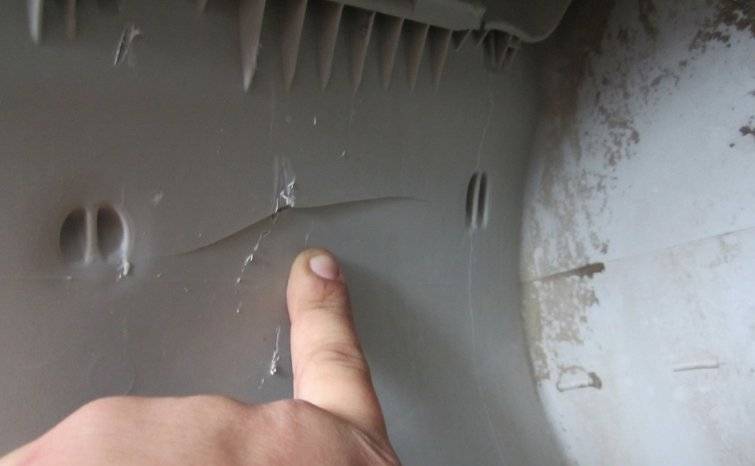
If the tank is leaking, there can be 2 reasons:
- cracked tank body;
- damage to the joints of parts.
Trying to fix cracks on your own with waterproof glue is useless: the result will not be enough for a long time. Therefore, the tank will have to be replaced or another gasket should be placed at the junction of the parts.
Replace the electronic control module

One of the most common malfunctions is associated with the electronic unit. No well-known brand is immune from this problem. The electronic module is responsible for thermal indication, water level, displays information on the operation of the device on the display, is responsible for the speed of washing and rinsing. Such breakdowns require replacement of the element.
Replace belt

If the drum rotates very slowly during washing, with scratching sounds, or does not rotate at all, an error code appears on the display, most likely the drive element is damaged. If the belt breaks, it can cut the wiring or damage the sensors. This problem can be caused by improper operation of the machine or wear over its service life. Moreover, narrow washers, as a rule, wear out faster due to the close arrangement of parts.
Surgical method or second aid to the washing machine
We observe all precautions by turning off the water and unplugging the washing machine from the mains. In the first step, we disconnect the hoses from the valves (which are located at the back of the machine), since water often remains in the hoses, you need to prepare a container to drain it.
- We unscrew the fasteners of the upper cover of the washing machine.
- The wire connectors from the coil usually have bright colors (for example, blue and red), similar to blockbusters, you need to remember their location and disconnect them.
- Using pliers, remove the fasteners from each of the four hoses.
- Note the location of the hoses and disconnect. Keep in mind that they may also have water in them, so it is best to prepare a towel.
- We unscrew the screw on which the valve is attached (it is located at the back) and take out the intake valve itself.
- We install a new valve for water supply by placing it in the bracket and fixing it with a screw using a screwdriver.
- We attach the hoses to the connectors and fix with clamps. We connect the coil wires.
- We put back the cover of the washing machine, giving it its original position, and fix the cover with the screws behind the machine. We connect the hoses to the new inlet valve.
- We connect the water and turn on the washing machine, check its performance.
- Open the back cover of the washing machine.
- A temperature sensor, a grounding terminal are connected to the heating element. To remove these wires, use the pliers to pull out the connectors.
- And then we take the socket wrench and unscrew the nut that holds the heating element.
- Then with a screwdriver, well, then with our hands, with up and down movements, pull the heating element towards ourselves, and together with the heating element, you need to pull out the rubber seal.
Here again a screwdriver will help.
When we insert a new heating element, be sure to pay attention to its guide, that is, look into the hole formed from the past heating element. There will be grooves for tight fit of the part.
It is best to lubricate the rubber seal of the new heating element with dishwashing gel before inserting it in order to insert it quickly and easily.
Then we insert the temperature sensor, tighten the nut and connect the wires.
Causes of malfunction
In the event of a breakdown, water can enter the drum of a washing machine both from the sewer and from the water supply. You can understand this by the color and smell, if cloudy water slowly appears in the drum, then this is clearly water from the sewer.
Moreover, when the machine draws water from the water supply system without stopping, the Aquastop system will not save you from overfilling the drum with water. The leakage protection sensor is fixed in the pan of the washing machine, and water will flow to the floor. Therefore, even the most advanced defense will be powerless in this case.
But what is the reason that the machine is picking up water? There are two such reasons:
- malfunction of the water supply valve;
- malfunction of the siphon valve or its absence;
- clogging of the drain system, as a result of which water flows back into the drum through the drain hose.
Elimination of breakage
So, when you see that the switched off washing machine is taking up water, immediately turn off the water tap. Only then proceed to troubleshooting. Do not forget to disconnect the machine from the mains while doing this. If the solenoid valve became the reason for the collection of water, then it must be replaced with a similar one. It's easy to do it yourself.
The filling solenoid valve is easy to access. In front-loading machines, it is located under the top cover of the case, and it must be removed. In vertical machines, you will have to remove the side cover. But first turn the clipper so that it is convenient to work and disconnect the water supply hose. When you see the valve, disconnect the hoses from it by releasing the clamps, and the electrical wires, remembering the polarity of these wires. Unscrew the valve from the machine body and remove it.

Since the solenoid valves cannot be repaired, we take a new part and connect it to the hoses. At the same time, we use new clamps for the reliability of the connections. Then, observing the polarity, we connect the electrical wires and fix the bay valve.
Before closing the lid of the washing machine, connect the water inlet hose and run a test wash. Check the connections for leaks. When you are sure everything is in order, reassemble the machine and put it back in place.
If the drum collects water from the sewer, then first of all, clean the siphon to which the drain hose from the washing machine is connected. Well, if the reason is the connection to the drain, then read the article Siphon for a washing machine.
Precautionary measures

And finally, how to avoid situations when the switched off machine draws water. Everything is quite simple, you need:
- After washing, close the water tap, if not, be sure to install it.
- Connect an anti-siphon valve to prevent waste water from getting back into the machine.
- Use a leakage protection system that is installed on the floor. As we noted, the protection system of the washing machine will not help in such a situation.
We hope the information in this article will help you prevent a flood, find the reason why water appears in the drum, and quickly eliminate it. Good luck!
Diagnostics
If there are breakdowns associated with draining the waste liquid in the washing machine, the owners can start the self-diagnosis function of household appliances.A similar function is available for many models of machines, thanks to which the technician will independently calculate what is the reason for the malfunction and display it on the information display.
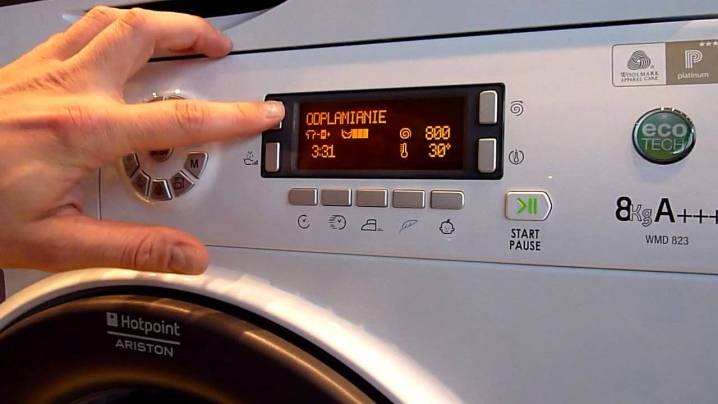
The self-diagnosis function is not available for all washing machine models. In this case, the owners can independently conduct a kind of revision of the device in order to find the cause of the malfunction. Let's see how this can be done.
- First of all, you need to understand that all diagnostic manipulations are allowed to be performed only with the machine disconnected from the network. Try not to forget about it.
- First, you should check the correctness of the set washing program if water accumulates in the drum. As mentioned above, the "Night" or "Hand" wash modes can lead to similar consequences. In such a situation, it is enough to cancel the program and start the drain.
- Inspect the drain hose of the unit carefully. The blockage could have formed due to the fact that in some place the hose was bent. Because of this, excess waste simply cannot go down the drain.
- The siphon could also get clogged if the device is connected through it. To check this, you can disconnect the hose and redirect it to the sink, and then start the drain process. If you notice that the liquid flows freely from the hose, then the reason lies in the sewage system. It is enough to clean it with specialized tools or call a plumber.
If you have completed all the above measures for diagnosing the equipment, and it still does not drain the spent liquid to the end (or completely), you can try to restart the device. Disconnect it from the mains, let it stand off for 15-20 minutes, and then restart the program responsible for draining.
Problems of program control
A malfunction of the electronic module is indicated on the display of the technical device in the form of an error code. This code tells you where to look for a breakdown. It makes sense to restart the program and turn on the washing machine again. If the simultaneous draining and filling continues, specialist assistance will be required.
With Zanussi devices, it happens that when water is collected, after 15-20 seconds, it starts to discharge, and the lights on the display blink. In this case, check:
- a heating element;
- motor contacts or winding breakdown;
- electronic board of the control module;
- pressure switch;
- brushes on the rotor (wear limit).
To clarify, the check is done operationally: the drum is scrolled, the temperature is monitored, and the filling is performed. Deciphering the error codes will help to correctly establish the cause of the self-draining.
Incorrect connection to the sewer
Such a malfunction becomes the cause of the constant drainage of water and occurs both in a newly installed and in a properly operated washing machine for many years. The problem is that the drain hose is located below the level of the tank, because of this, the liquid is not retained, but is constantly drained into the sewer. The machine, on the other hand, stably replenishes the lost water. The liquid in the tank does not have time to heat up, so the heating element works constantly, which is fraught with its failure.
For proper operation, manufacturers recommend laying the hose at a level not lower than 0.5 m from the floor. This is achieved either by installing it in special latches on the back of the machine with a trace around it, or using the included holder hook, which is then hung on the edge of the bathtub or sink. It is possible to connect the drain hose both to the siphon of a bath or sink, and directly to the sewer pipe itself, by cutting a branch into it. But then a loop should be made above 0.5 m to prevent premature drainage of the liquid. This will help prevent unpleasant odors from the drain from entering the washing machine. You can do this type of work yourself.
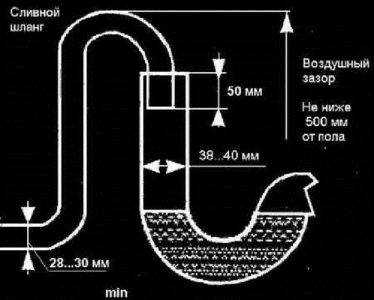
If there is no access to the sewer pipes due to their termination and it is impossible to see at which level the drain hose is connected or the presence of a loop, you can check for fluid leakage from the machine. To do this, you need to turn on any mode and draw water into the tank. Then press pause and open the car. A falling level means an incorrectly connected hose; to eliminate this, you will have to disassemble the wall. If the water does not leave in this way, but only during the operation of the machine, then there is a malfunction in one of the devices of the washing unit.
Main reasons
The normal working cycle of the machine is accompanied by the supply and output of water. This happens at least 2 times. However, if the unit does not hold water and constantly drives back and forth, then you will have to deal with the problem.
All reasons are divided into 2 blocks:
- incorrect installation;
- reoccurring malfunction.
Water flows into the tank. After washing, the machine is released by the operation of the pump located at the bottom of the structure. The water comes out through the connected hose.

For the machine to work properly, the end of the hose should be at least 60 cm from the floor, maximum - 1 m. That is, if compared with the level of the middle of the drum, then this value is about 10-15 cm above this level.
If the hose is too low, then the water flows by gravity into the sewer. At the same time, the washing machine starts pumping again, because a vacant space is vacated. A new portion of water goes away in the same way, and the cycle starts over.
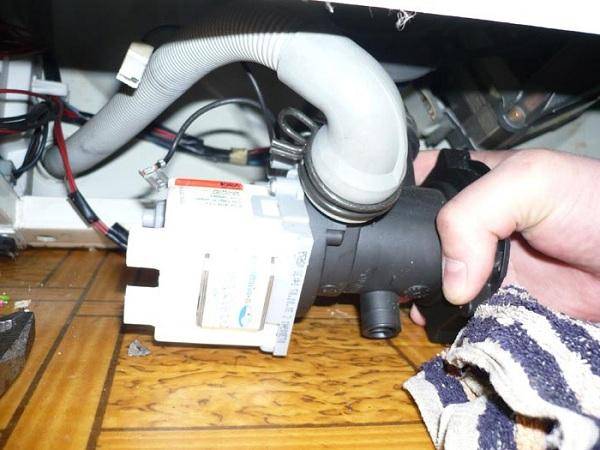
Among the causes of the malfunction are also distinguished:
- Breakage of the water level sensor. This device shows the water content in the tank and is also responsible for giving a command to the inlet valve. The pressure switch determines the filling of the machine by the value of the pressure of the water column. In the event of a blockage in the pressure tube of the sensor, the device may give incorrect information. The consequence of this will be the constant filling of the machine. The sensor will need to be repaired or replaced.
- Water supply outlet valve malfunction. Breakage can be only one membrane or the entire valve, as a result of which water seeps through it even when closed. The inlet valve, which is responsible for the water supply, is not working correctly.
- Siphon effect. If there is a blockage in the sewer pipes, and they are still being used in neighboring apartments, the pressure inside is reduced and draws in moisture, after which a signal is received that it is necessary to fill in more. This is how the device draws water all the time and immediately loses it. It is impossible to wash things in this mode.
- Damage to parts. In a washing machine, there are a number of units that are responsible for the circulation of moisture within the system. If one breaks, it causes the device to lose and replenish the liquid level in the reservoir all the time. It can be difficult to find the source of a malfunction; it is better to entrust it to a specialist.
What to do to avoid breaking the machine?
Washing machine care and maintenance
Correct and timely cleaning of its component parts is extremely important for reducing the consumption of washing powder and for the good functionality of the machine. Certain parts of the unit constantly require cleaning, namely: door seal, filter, mesh on the supply pipe.
Correct wash. How to wash bed linen?
Of course, the laundry must be sorted before washing. Sorting correctly by color and material will help the laundry keep its original appearance and make life easier for the washing machine.
If the laundry is not dirty and the goal is simply to freshen it up, use the cold setting and a short, incomplete program. By adhering to these simple rules, you can save energy and take care of the drum of the machine.
How to choose the right detergent and determine its amount?
Detergents are divided into many types and subspecies, but the main ones known today are various types of soaps, powders and gels.If the efficiency of washing is in the first place, then it is necessary to use washing powder. If the rinsing stage is important, purchase a washing gel. If most of the washed items are dark, sometimes you can notice white streaks on the clothes - the remainder of zeolites.
This is a common ingredient in all laundry detergents. It is harmless to human skin, but it will probably damage clothes, so it is better to wash dark clothes with a gel that does not leave such marks.
As for the dosage of funds, it is important to use them in the amount prescribed in the instructions. Often people like to add more washing powder or gel, thinking that this will help optimize the wash, but in fact, this only gives negative consequences.
Firstly, the environment becomes polluted, and secondly, the filter clogs up faster.
As a result, you need to give a few tips, thanks to which you can extend the life of the washing machine and its main components. Under no circumstances should you step on the washing machine or place heavy equipment / objects on it.
Pockets should be checked carefully. It is recommended to clean the rubber parts inside the machine after each time; this can be done with an ordinary dry cloth. The machine must be unloaded immediately after the machine has stopped. When things are wet, they become heavier, which puts a lot of stress on the drum.
You should turn on an empty machine at the maximum temperature every month if the software does not self-clean.

